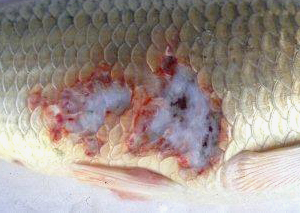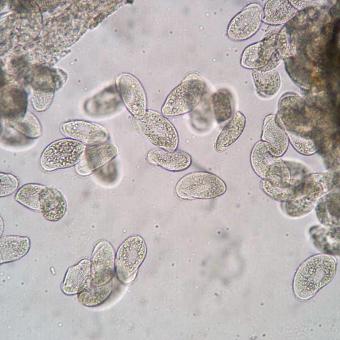KOI Health
 When it comes to koi nothing trumps good water quality. We are first going to discuss water quality because its the foundation for the health of your koi.
When it comes to koi nothing trumps good water quality. We are first going to discuss water quality because its the foundation for the health of your koi.
Lets Talk Sick Koi:
Koi Sores
For koi sores, depending on severity, you need to treat the wounds. First, sometimes just getting the koi into good, clean and warm water as mentioned will heal them if the sores or sick koi have not progressed too far. Raising the water temperature to at least 70 degrees (preferably 80) will go a long way in healing your koi because the koi’s immune system is fully activated at that point and sometimes it can fight off the infection on its own. You can also add salt as it will help with their slime coat and relieve some stress. If the wounds aren’t too bad, you can get away with just adding a bandage. The way to do this is to dry the area first, then apply Betadine (only do this once as multiple applications can cause the wound to not heal properly). Then once the Betadine is done, you can add Neosporin to the wound and then dental fixture powder on top of that. You can do most of this just using your finger. Finally you can add liquid bandage to seal off everything and keep the bandage on for up to 24 hours while the koi is healing. Sometimes you need to do this multiple times. If you do need to do this multiple times just cut out the Betadine because that can only be used once, as mentioned. Then return your koi to the pond or quarantine tank.
Most times the koi also need antibiotics to heal if the wound is deep. People used to use antibiotic food milled in. This antibiotic food is no longer available due to strict government rules that bans its use nowadays. Please note this also poses a problem if the koi are too sick to eat. At this point if the wound is bad, you need to inject your koi with antibiotics. The most common is to inject with Baytril at least 3 times everyday and then sometimes 2 more times every other day if needed. You can get Baytril online yourself and buy syringes and do it yourself if you wish to still save your koi at this point. It is easier than it sounds. Or you can contact your local vet or other service to do it for you. This is often not a option for some as it can be very expensive. Please contact us for more information if you decide to give this a go for your self.
Next we recommend to try and find out what caused the sores or sick koi in the first place. Sometimes it is just the water quality. However even if it was just water quality that caused the fish to be stressed, most often this can lead to secondary problems like parasites or flukes. We highly recommend learning how to use a microscope and doing skin scrapes and gill biopsies. If your water quality wasn’t bad, then most likely you just have parasites or worms effecting the fish. Either way you can look below on how to also treat parasites and/or worms.
Please Note: If a koi is bloated looking(pine cone disease) it just means that there is an internal infection and your koi will die if it does not receive antibiotic injections. Anytime you see any kind of sore or bump that looks like its starting from the inside of the koi, that is almost always an internal infection and it needs antibiotics to heal. Just like a human would die from an internal infection without antibiotics, it is the same way with fish.


 The cycle is the buildup of good bacteria in any new system. Any new system takes time to achieve this buildup. To get a cycle started you need something for the bacteria to consume and grow into larger colonies. Then ammonia, nitrite, and nitrate can be broken down properly when your fishes start expelling waste. If the cycle is not complete before adding fish, you will harm them. First, the cycle starts with ammonia (you can add food or any kind of waste really to get this cycle started). You can also google this. During this time it is actually good to see the ammonia levels going up. Once the levels of ammonia are detectable, you need to wait for the nitrite levels to be detectable. Once the Nitrite levels are detectable it means that the cycle is starting and there is good bacteria consuming the ammonia. Once the ammonia is back down to zero the first stage of the cycle has been completed. (Please note this can take days to weeks.) Now you need to watch your nitrite in the same way. Now the third step is to check your nitrates. Once you have a detectable level of nitrates the good bacteria are starting to consume your nitrite. Once your nitrite levels are back to zero, your cycle is complete! When the ammonia and nitrite has spiked and gone back to zero you can now add fish! Note: Nitrite sometimes can take longer then ammonia.
The cycle is the buildup of good bacteria in any new system. Any new system takes time to achieve this buildup. To get a cycle started you need something for the bacteria to consume and grow into larger colonies. Then ammonia, nitrite, and nitrate can be broken down properly when your fishes start expelling waste. If the cycle is not complete before adding fish, you will harm them. First, the cycle starts with ammonia (you can add food or any kind of waste really to get this cycle started). You can also google this. During this time it is actually good to see the ammonia levels going up. Once the levels of ammonia are detectable, you need to wait for the nitrite levels to be detectable. Once the Nitrite levels are detectable it means that the cycle is starting and there is good bacteria consuming the ammonia. Once the ammonia is back down to zero the first stage of the cycle has been completed. (Please note this can take days to weeks.) Now you need to watch your nitrite in the same way. Now the third step is to check your nitrates. Once you have a detectable level of nitrates the good bacteria are starting to consume your nitrite. Once your nitrite levels are back to zero, your cycle is complete! When the ammonia and nitrite has spiked and gone back to zero you can now add fish! Note: Nitrite sometimes can take longer then ammonia.




 Note: The sooner you act when you see a sore or sick koi, the better and easier it will be to treat. After awhile you will begin to notice when your fish aren’t acting like they normally do.
Note: The sooner you act when you see a sore or sick koi, the better and easier it will be to treat. After awhile you will begin to notice when your fish aren’t acting like they normally do.